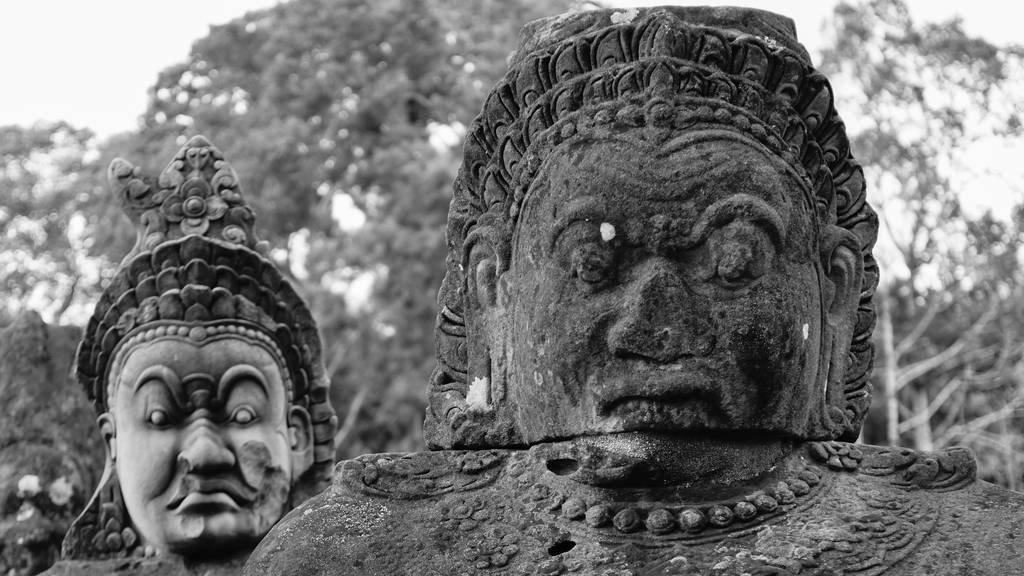At Angkor Wat, you’ll uncover an incredible showcase of Hindu mythology carved into ancient stone walls. The temple’s five towering spires represent Mount Meru, home of the gods, while over 2,000 celestial dancers accompany scenes of Vishnu maintaining cosmic balance. You’ll find epic battles between Rama and Ravana, the famous “Churning of the Ocean of Milk,” and intricate depictions of four-armed Vishnu. The deeper you investigate these 900-year-old corridors, the more divine secrets they’ll reveal.
Key Takeaways
- The “Churning of the Ocean of Milk” bas-relief depicts gods and demons in an epic tug-of-war symbolizing cosmic balance.
- Extensive wall carvings showcase Vishnu’s divine presence and his avatars Rama and Krishna in legendary battle scenes.
- The Ramayana epic unfolds across temple walls, featuring Rama’s battle with Ravana and return to Ayodhya.
- Over 2,000 celestial dancers (Apsaras) adorn the temple walls, representing the connection between earthly and heavenly realms.
- Shiva’s influence appears in the Roluos temple group through striking lingams, while Brahma is honored in various shrines.
The Divine Origins of Angkor Wat’s Sacred Architecture
When King Suryavarman II began constructing Angkor Wat in 1116 C.E., he wasn’t just building another temple – he was creating a physical bridge between Earth and the divine sphere!
You’ll find cosmic symbolism woven into every aspect of this architectural marvel. According to ancient legends, divine architects themselves guided the temple’s creation, and you can see their influence in the perfect astronomical alignments.
The central tower rises like Mount Meru – the mythical home of the gods – while the surrounding galleries mirror cosmic mountain ranges and oceans!
Want to experience this celestial connection yourself? Visit during an equinox when the setting sun aligns perfectly with the central tower.
It’s the exact same awe-inspiring sight that worshippers witnessed 900 years ago, connecting you directly to both Earth and heaven’s spheres.
Vishnu’s Presence in Temple Wall Carvings
As you investigate Angkor Wat’s massive walls, you’ll uncover an incredible showcase of Vishnu’s divine presence carved into nearly every surface!
You’re walking through a massive stone catalog of Hindu mythology, where over 2,000 celestial dancers accompany scenes of Vishnu maintaining cosmic balance throughout the universe.
Don’t miss the temple’s most famous bas-relief – the “Churning of the Ocean of Milk,” where you’ll spot Vishnu orchestrating an epic tug-of-war between gods and demons!
Keep your eyes peeled for Vishnu’s avatars, especially Rama and Krishna, depicted in intricate battle scenes and mythological episodes.
Some carvings even retain their original paint, giving you a glimpse of how vibrant these walls once looked.
Each polished detail tells part of Vishnu’s timeless story of protection and preservation.
Mount Meru: The Celestial Home of Hindu Deities
Beyond Vishnu’s magnificent wall carvings, the temple’s most powerful spiritual symbol towers above you – Mount Meru, the cosmic mountain that Hindu deities call home!
You’ll uncover how this divine peak isn’t just any mountain – it’s the universe’s golden center, where gods dwell and cosmic energies converge. As you investigate the temple’s design, you’re actually walking through a symbolic representation of Mount Meru and the Divine Ascent to enlightenment!
| Feature | Cosmic Significance |
|---|---|
| Height | 84,000 yojanas high |
| Central Peak | Home of major gods |
| Four Directions | Sacred rivers flow outward |
| Surrounding Seas | Seven concentric rings |
| Divine Waters | Lake of immortality |
The temple’s soaring towers mirror Mount Meru’s spiritual elevation, with each level representing your own potential expedition toward divine connection. You’re not just viewing architecture – you’re experiencing the cosmos itself!
Epic Tales From the Ramayana on Temple Walls
Standing before Angkor Wat’s majestic walls, you’ll uncover an incredible visual narrative from one of Hinduism’s greatest epics – the Ramayana!
These intricate 12th-century carvings bring ancient stories to life through masterful Khmer storytelling that’ll leave you spellbound.
You’ll witness epic battle scenes where Rama confronts the demon king Ravana, carved in stunning detail on the north wing.
Don’t miss the northwest tower, where you’ll find dramatic depictions of Sita’s trial by fire and Rama’s triumphant return to Ayodhya!
These Ramayana adaptations aren’t just art – they’re windows into Cambodia’s rich cultural heritage.
Today, these tales continue to inspire local traditions, from the masked lkhon khol dance to the Royal Ballet of Cambodia.
It’s living history etched in stone!
Shiva’s Influence in the Roluos Temple Group
Deep within Cambodia’s ancient Roluos temple complex, you’ll uncover the mighty presence of Lord Shiva, whose influence shaped these remarkable 9th-century structures!
As you investigate, you’ll witness how Shiva worship dominated these sacred grounds, from the towering brick sanctuaries of Preah Ko to the majestic step pyramid of Bakong.
You can’t miss the striking lingams – Shiva’s symbolic form – housed within six brick sanctuaries at Preah Ko.
These aren’t just any temples; they’re architectural legacies that set the stage for the famous Angkor Wat!
Marvel at the intricate carvings depicting Hindu mythology, where stories of Shiva dance across ancient walls.
Through a fascinating blend of Indian and Khmer traditions, these temples showcase how local craftsmen transformed religious devotion into lasting architectural masterpieces.
Sacred Dances of the Apsaras at Angkor
Moving from Shiva’s powerful presence in the temples, you’ll uncover a likewise enchanting aspect of Angkor’s heritage – the mesmerizing world of Apsara dancers!
When you investigate Angkor Wat’s walls, you’ll find these celestial dancers frozen in stone, telling ancient tales through their graceful poses. Apsara symbolism runs deep in Hindu-Buddhist mythology, where these divine beings entertained both gods and kings.
Today’s performances keep this tradition alive with dancers mastering an incredible 1,500 distinct movements! Dance mythology comes to life as performers in silk brocade and glittering headdresses move to the haunting melodies of the pinpeat orchestra.
- Experience the hypnotic hand gestures that tell stories of creation
- Witness living heritage preserved through UNESCO recognition
- Feel the connection to ancient times as divine dancers bring stone carvings to life
The Battle Between Gods and Demons in Stone
As you investigate the western section of Angkor Wat’s north gallery, you’ll encounter one of the most dramatic scenes ever carved in stone – the epic battle between gods and demons!
Watch as Varuna, the mighty sea god, rides his dragon-like Makara chariot into divine conflict with the asuras. You’re witnessing an eternal struggle between good and evil, where battle symbolism comes alive through intricate details carved by master Khmer craftsmen.
Look closely, and you’ll spot mythological superstars like Indra atop his three-headed elephant Airavata, and Kartikeya soaring on his peacock mount!
This massive relief tells more than just a story – it’s a window into ancient beliefs where gods and demons clash in an endless dance of cosmic forces.
And trust us, you won’t find a more impressive battle scene anywhere else!
Hindu Cosmology Reflected in Temple Design
While our previous gallery showcased epic battles, you’ll find that Angkor Wat‘s entire design tells an even grander cosmic story!
When you investigate this magnificent temple, you’re actually walking through a three-dimensional map of Hindu cosmology. The temple’s brilliant architects created perfect architectural harmony by aligning every element with cosmic principles – from its east-west orientation to its five soaring towers representing Mount Meru‘s peaks.
Each step through Angkor Wat reveals cosmic secrets, as the temple mirrors Hindu principles in its perfect architectural design.
You’re literally stepping through the universe as the ancient Khmers saw it:
- The central tower stands as Mount Meru itself, home of the gods
- The moat around the temple represents the cosmic ocean
- The outer walls symbolize the mountains that encircle the world
Can’t you feel the power? Each gallery you climb takes you closer to the divine domain, just as the temple’s original builders intended!
Royal Dedications to Divine Protectors
Beyond its magnificent architecture, Angkor Wat stands as a powerful tribute to the Khmer Empire’s devotion to Hindu deities. You’ll uncover how royal patronage shaped this incredible temple, which King Suryavarman II dedicated to Vishnu. Through careful temple construction, the Khmer rulers created a masterpiece that’d make even the gods smile!
| Deity | Temple | Royal Patron |
|---|---|---|
| Vishnu | Angkor Wat | Suryavarman II |
| Shiva | Pre Rup | Rajendravarman II |
| Brahma | Diverse Shrines | Multiple Kings |
When you investigate Angkor Wat’s grand halls, you’re walking through centuries of spiritual devotion. The temple’s dedication to Vishnu wasn’t just a religious choice – it was a bold statement of the Khmer Empire’s power and their deep connection to the divine. You’ll find hints of this devotion everywhere, from towering spires to intricate carvings!
Sacred Symbols and Their Divine Meanings
Inside Angkor Wat’s towering walls, you’ll reveal a trove of sacred symbols that tell powerful stories of Hindu mythology and cosmic beliefs.
As you investigate, you’ll find out how sacred geometry and divine numerology shape every corner of this magnificent temple. The five central towers aren’t just architectural marvels – they represent Mount Meru’s peaks, while the vast moat mirrors the cosmic ocean surrounding the mythical mountain!
Key symbols you’ll encounter:
- The mystical number 108 appears throughout the temple’s design, reflecting Hindu cosmic perfection
- Four-armed Vishnu carvings guard the temple walls, wielding symbols of divine protection
- Intricate depictions of Apsaras (celestial dancers) connect the earthly domain with heavenly dimensions
Get ready to witness how ancient Khmer artists transformed stone into spiritual storytelling that’s stood the test of time.
Conclusion
You’ll find that Cambodia’s ancient temples are more than just stone structures – they’re gateways to understanding Hindu mythology and cosmology. As you investigate Angkor Wat’s intricate carvings and sacred spaces, you’re walking through stories of gods, demons, and divine battles that have shaped human imagination for centuries. Whether you’re an art lover, history buff, or spiritual seeker, these temples have preserved divine tales that’ll leave you in awe!



